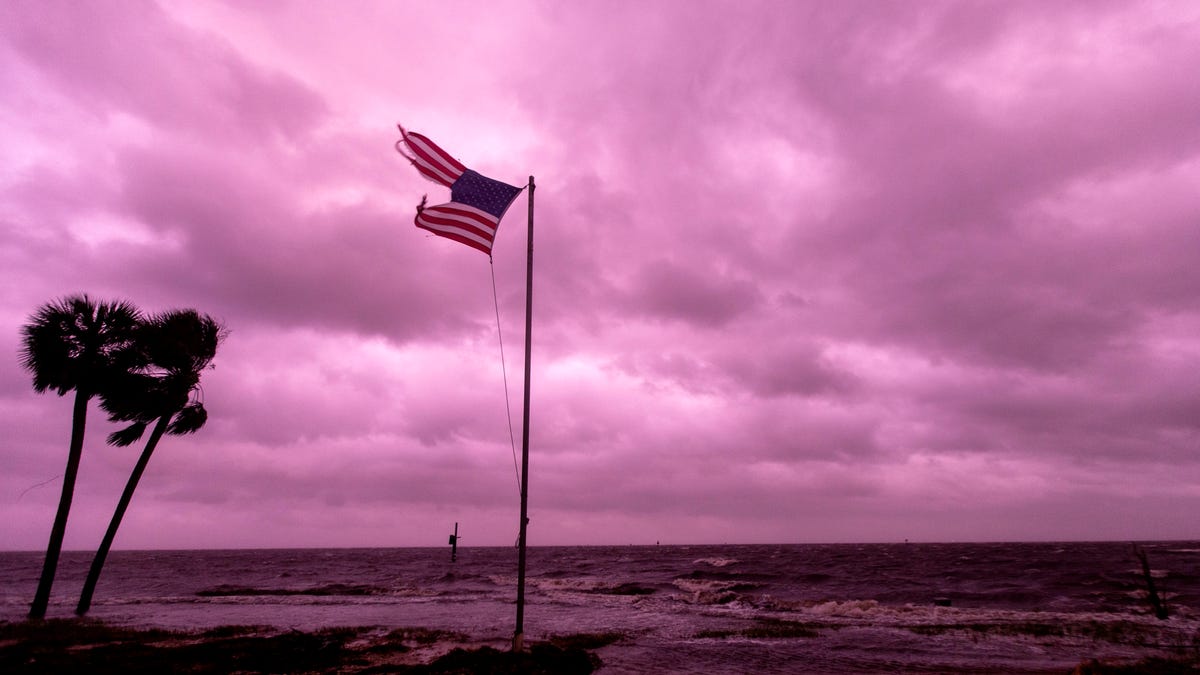After Hurricane Michael, Florida skies turned purple. Here's why
Purple rain: After devastation, sometimes beauty comes.

A battered American flag flies against a purple sky on Florida's Shell Point Beach Wednesday night.
America the Beautiful sings of "purple mountain majesties," but after deadly Hurricane Michael passed through Florida's panhandle, it was the skies that turned an eerie purple.
Florida Gov. Rick Scott called the hurricane an "absolute monster." As of Thursday night, CNET sister site CBS News reported that at least six people died when the Category 4 hurricane, now downgraded to a tropical storm, made landfall on Florida's Gulf Coast on Wednesday.
But even after the hurricane had moved on, its weather pattern affected the Florida skies. Reporters and residents shared images of post-storm skies ranging from a light lavender to a deep violet, and it turns out there's a scientific explanation for the unusual hues.
Purple sky here in Lake City Fl where I’m with @MikeQReports covering Hurricane Michael for @FCN2go #hurricanemichael2018 #HurricaneMichael #Weather #FirstCoastNews pic.twitter.com/SuAUswUXYu
— Nick Petrillo (@nicknewsdc) October 10, 2018
WOW. I’ve never seen such a purple sky before! This is in Lake City. Rain & wind starting to pick up here now. #Michael @FCN2go #FCNstorm @fcntim @_WeatherStove @WeatherLauren pic.twitter.com/YFld0O0nza
— Shelby Danielsen (@NewsShelby) October 10, 2018
Post #Michael sunrise. We are the lucky ones, First Coast. 💕🌅 pic.twitter.com/J9ndGpkruW
— Lauren Rautenkranz (@WeatherLauren) October 11, 2018
The sky was purple today. #HuricaneMichael pic.twitter.com/nJlpzvHOkU
— Bella (@girllikethat68) October 11, 2018
The sky was purple tonight... we love hurricane weather 😂💜 pic.twitter.com/zRSUl3ZShI
— Kaitlyn LOVES SHORELINES 🌊🌊 (@JustKaitlyn564) October 10, 2018
There was enough interest in the purple palette that Florida-based First Coast News produced a short video of meteorologist Lauren Rautenkranz explaining the science behind it, noting that we normally see blue skies because blue wins out in a sort of scientific battle with violet.
"As sunlight shines down to Earth, most of the colors of the spectrum are able to reach the surface uninterrupted," Rautenkranz said in the video. "But the shorter wavelengths, blue and violet, are scattered in every direction. This light bounces from particle to particle until it eventually reaches your eyes. But the sky doesn't appear violet and blue because of our eyes' limitations."
Normally, she said, our eyes can only detect blue, because violet is the shortest wavelength of the color spectrum. But after the hurricane, the conditions were right for purple to make an appearance. The air was super-saturated, dew points were in the mid- and upper 70s, the sun was setting, and the hurricane's clouds hung low to the ground.
"This combination allowed our eyes to see (the sky's) true colors, since violet is there to begin with, we just don't usually get to see it," Rautenkrantz said. "The light was scattered around the moisture in the air, causing the magical purple color."
Why was the sky purple after Hurricane #Michael? 🤔@FCN2go #FCNStorm pic.twitter.com/KvxUoQ00hs
— Lauren Rautenkranz (@WeatherLauren) October 11, 2018
The weather phenomenon brought some beauty to the destructive storm.
"The color of the sky was beautiful," Tracy Walker tweeted in response to the video. "I wish that we could see that more often, minus the hurricane of course!"
The color of the sky was beautiful! I wish that we could see that more often, minus the hurricane of course! Thx!
— Tracy Walker (@tracyfromjax) October 11, 2018
But not everyone saw it as newsworthy.
"Why did everyone put the purple sky on their story, like I can't walk outside and look up?" wrote one Twitter user.
why did everyone put the purple sky on their story like i can’t walk outside and look up lmao
— jeremiah (@lovelyjerxmy) October 11, 2018
NASA turns 60: The space agency has taken humanity farther than anyone else, and it has plans to go further.
Taking It to Extremes: Mix insane situations -- erupting volcanoes, nuclear meltdowns, 30-foot waves -- with everyday tech. Here's what happens.

